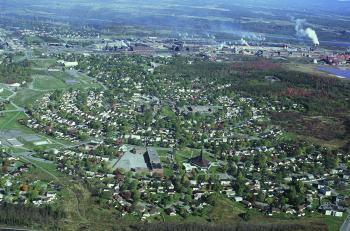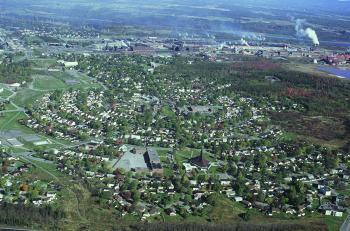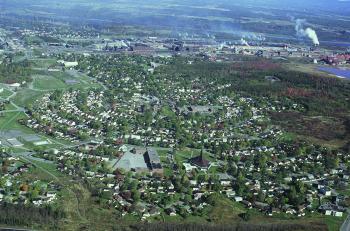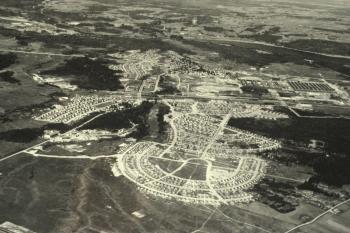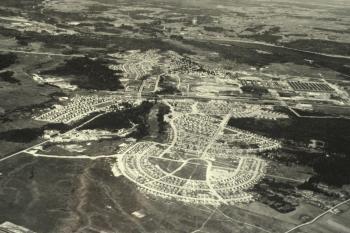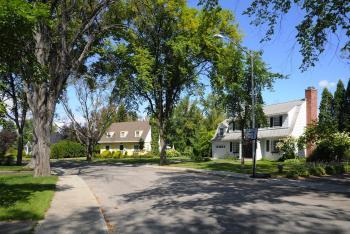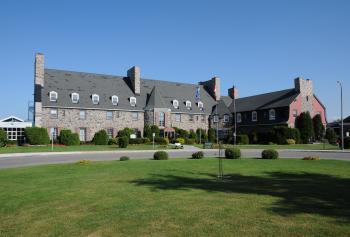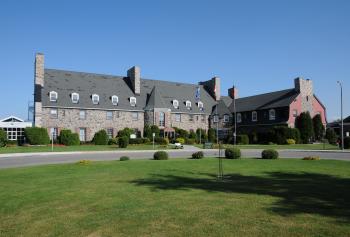A carefully planned company town in Quebec built by a fiery American industrialist as a “utopia” for the working man is being put forward for recognition as a UNESCO World Heritage Site.
Arvida was built in 1927 by Alcoa (Alcan in Canada) and its president, Massachusetts-born Arthur Vining Davis, who was the driving force behind creating a model metropolis that became home to the largest aluminum smelter in the world.
Located 240 km north of Quebec City, Arvida was known as “the City Built in 135 Days” and in its heyday had 14,000 residents. It was lauded by The New York Times as a “model town for working families” on “a North Canada steppe.”
“Arvida is an industrial town planned around an integrated aluminum smelter that became in a few years the most important one in the world,” says Carl Dufour, a local city councillor who is spearheading the effort to get Arvida on the World Heritage list.
Arvida was built in 1927 by Alcoa (Alcan in Canada) and its president, Massachusetts-born Arthur Vining Davis, who was the driving force behind creating a model metropolis that became home to the largest aluminum smelter in the world.
Located 240 km north of Quebec City, Arvida was known as “the City Built in 135 Days” and in its heyday had 14,000 residents. It was lauded by The New York Times as a “model town for working families” on “a North Canada steppe.”
“Arvida is an industrial town planned around an integrated aluminum smelter that became in a few years the most important one in the world,” says Carl Dufour, a local city councillor who is spearheading the effort to get Arvida on the World Heritage list.
It was a time when aluminum was known as the “magic metal of the 20th century.”
During World War II the smelter was expanded and a large hydroelectric complex was built on the Saguenay River. Because of its importance in the war effort, Arvida was guarded by anti-aircraft batteries.
“It provided 90 percent of the aluminum to the allies for making airplanes, among other things,” says Dufour.
Lucie Morisset, a professor of urban studies at the University of Quebec at Montreal who is also involved in the heritage campaign, says Arvida’s aluminum was so vital during the war that it “helped put Canada on the world map.”
The town was planned from the start by Davis, who hired a New York architect to integrate the most up-to-date urban designs of the time. It included schools and churches for several religious denominations, broad avenues, and a business district.
During World War II the smelter was expanded and a large hydroelectric complex was built on the Saguenay River. Because of its importance in the war effort, Arvida was guarded by anti-aircraft batteries.
“It provided 90 percent of the aluminum to the allies for making airplanes, among other things,” says Dufour.
Lucie Morisset, a professor of urban studies at the University of Quebec at Montreal who is also involved in the heritage campaign, says Arvida’s aluminum was so vital during the war that it “helped put Canada on the world map.”
The town was planned from the start by Davis, who hired a New York architect to integrate the most up-to-date urban designs of the time. It included schools and churches for several religious denominations, broad avenues, and a business district.
The houses sit on spacious lots on tree-lined streets, each with its own individual architectural style.
“It was designed to give the workers—not just the foremen or executives, but all of them—the best living conditions they would find in the country, and probably on the planet,” says Morisset.
In 1928, Henry Ford also endeavoured to build a unique company town. But his “Fordlandia” in Brazil’s Amazon jungle, whose purpose was to supply rubber for the Ford Motor Company in the United States, failed for a variety of reasons.
“One could say that Arthur Vining Davis’s dream for Arvida was much the same, the difference being that Arvida succeeded where Fordlandia failed, and became the world’s aluminum capital where workers had a strong feeling of belonging,” says Morisset.
“It was designed to give the workers—not just the foremen or executives, but all of them—the best living conditions they would find in the country, and probably on the planet,” says Morisset.
In 1928, Henry Ford also endeavoured to build a unique company town. But his “Fordlandia” in Brazil’s Amazon jungle, whose purpose was to supply rubber for the Ford Motor Company in the United States, failed for a variety of reasons.
“One could say that Arthur Vining Davis’s dream for Arvida was much the same, the difference being that Arvida succeeded where Fordlandia failed, and became the world’s aluminum capital where workers had a strong feeling of belonging,” says Morisset.
Like Ford, Davis named his creation after himself, taking the first two letters of each part of his name to comprise Arvida. During the 1950s and 1960s, the smelter employed up to 7,500 people.
Today Arvida, which has merged with the city of Saguenay, has about 12,000 residents. The smelter and other related plants, currently owned by Rio Tinto Alcan, are still in operation, though on a smaller scale.
Morisset says Arvida deserves World Heritage status given its history and legacy as a meticulously planned community that was a social/industrial utopia—“something no city up to this point on the World Heritage list can claim.”
“One could say that the World Heritage list would be more complete with Arvida, or is incomplete without it, because it represents a part of history that no other place, to our knowledge, represents so well and to that extent.”
Today Arvida, which has merged with the city of Saguenay, has about 12,000 residents. The smelter and other related plants, currently owned by Rio Tinto Alcan, are still in operation, though on a smaller scale.
Morisset says Arvida deserves World Heritage status given its history and legacy as a meticulously planned community that was a social/industrial utopia—“something no city up to this point on the World Heritage list can claim.”
“One could say that the World Heritage list would be more complete with Arvida, or is incomplete without it, because it represents a part of history that no other place, to our knowledge, represents so well and to that extent.”
Dufour says the request for recognition will soon be submitted to Parks Canada—the first step in applying for recognition as a World Heritage Site.
He says Arvidians are proud of their community and are firmly behind pursuing the UNESCO designation.
“When citizens believe in it, all is possible. And in my opinion, history is waiting for us in this respect.”
He says Arvidians are proud of their community and are firmly behind pursuing the UNESCO designation.
“When citizens believe in it, all is possible. And in my opinion, history is waiting for us in this respect.”
